TLP management procedure. Types of orders and 8 basic steps
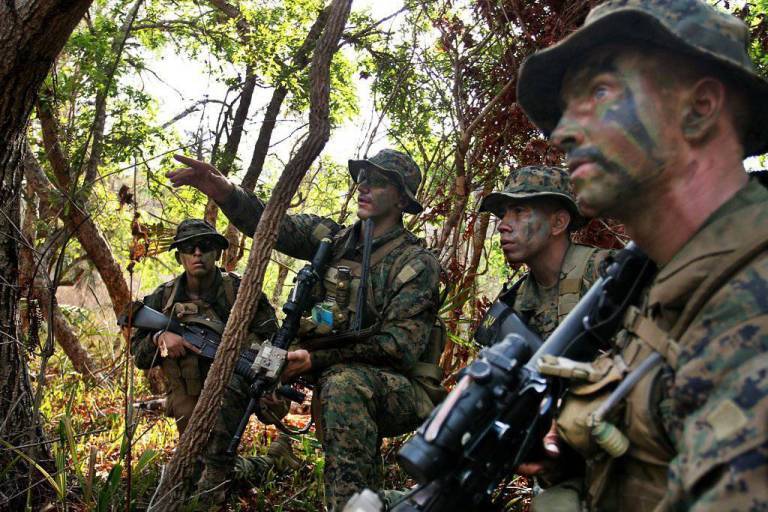
The Divisional Leadership Procedure (TLP) is a dynamic process that needs to be adapted as operational variables change. During operation, commanders plan an expected outcome based on the unknown actions of a potentially hostile force. Some plans succeed, while others, as shown story and experience, no.
TLP is a combat planning exercise for small-unit planning and guidance for planning a specific operation based on potential outcomes and alternatives. Training, combat drills and standard operating procedures are key in case things don't go according to plan. Soldiers and commanders must have the confidence, foundation, and muscle memory to instinctively jump to alternate courses of action or contingencies and succeed in doing so.
The US Army has procedures and guidelines for just about everything a commander might encounter in military life. Some procedures are rigidly structured, with no gray area or room for deviations, such as articles of the charter regarding uniforms or instructions for parachute packing. Others have room for interpretation and options, like TLP. They provide a flexible framework due to the variables and factors involved in scheduling the job. While some considerations weigh more than others, each step is equally important and results in a clearer picture of the operation ahead.
Basic terms of the department management procedure
WARN - Warning Order - a preliminary order (order), where it is reported that a combat order is being prepared. This order (order) is communicated orally to the personnel as soon as possible (no later than 3–7 minutes after receiving the assignment, and the written version in time should not exceed a third of the total time to prepare for the assignment). The commander focuses on analyzing the general situation and on the tasks that his subordinates must perform in order to successfully plan and prepare for an operation.
In all cases, WARNO must define:
- What is the task assigned to the unit.
- Where and when the combat order will be issued.
- Units taking part in the mission, including those attached to it.
- Goals of the upcoming mission.
- Schedule of the operation with a detailed definition of all actions (including food intake) before the operation.
- Settings for training sessions.
* When setting the problem, the following algorithm of five points must be used: who (subdivision), that (tasks), when (time), where (location and coordinates) and why (the purpose for which it needs to be done).
For example: 4 platoon DESTROY enemy in the area object "Alpha", not later 16:00, with the aim of creating favorable conditions for carrying out an attack battalion.
This "5 point" rule is mandatory for both WARNO and OPORD and, in general, for any order.
An additional WARNO will be issued with the receipt of more detailed information. And depending on the situation or the specifics of the assignment, there may be several such orders.
OPORD - An Operation Order is a combat order (command) issued by a commander of any level to his subordinates in order to begin a coordinated execution of a combat mission. The order describes the situation, information about the enemy, the commander's plan, the phases of the mission, specific (specified) tasks for subordinates, the forces and means that are given or taken away, the phase of the main effort, the areas and coordinates of the gathering point, alternate routes for reaching the target and withdrawing from targets, medical support and casualty reception, etc.
FRAGO - Fragmentary Order - a corrective order, issued only when necessary, when the operational (tactical) situation requires changes in OPORD.
SMESC - an order of 5-line format, most often issued at the highest levels of management, since there is more time for planning. Also a mandatory component of any order. The abbreviation is made up of the following words:
Situation (situation),
Mission (task)
Execution (execution),
Support and Provision (support and provision),
Сommunication and Control
METT-TC - an analysis procedure, which means:
Mission (exercise),
ENEMY analysis (analysis of the enemy),
Terrain and weather
troops available (our available troops),
Time (time) or Tactics (tactics),
Civilian considerations (civil)
SALUTE HIM - an adversary analysis procedure, which means:
Size (number, number),
Activity (activities, actions),
Lease (location, place),
uniform (dress),
Time (time),
equipment (equipment, weapons, weapon),
Habits (habits, behavior),
Intent (intentions, intention),
Moral (fighting spirit).
An integral part of the METT-TS, it is included in the Enemy analysis item.
OAKOC - terrain analysis procedure, which means:
Observation and firing sectors (observation and firing sectors),
Approach routes (approach paths),
Key area (key areas of the terrain),
obstacles (obstacles),
Camouflage (disguise).
Part of the METT-TS, Terrain and weather item.
WITH THE - Courses of Action - development and comparison of combat options, analysis and selection of combat options, as well as the development of an operational plan or order for a combat mission.
Battle orders and their types
The junior commander, like most generals, spends a lot of time planning. He plans several courses of action, many contingencies, and events that he hopes will never materialize. Ultimately, the commander plans to be prepared to confidently and successfully lead his soldiers in a situation for which likely scenarios and potential outcomes have been considered.
We observe the result of planning when the commander issues his combat order.
Battle Order - This is a means by which the unit commander receives and transmits information from the earliest notification of when and what kind of operation will be carried out, to the last stages of execution.
There are three main types of orders: WARN, OPORD и FRAGO... All of them are absolutely necessary for the success of the mission, although some of them (for example, WARNO) can be skipped: it all depends on the time the commander has at his disposal.
In a tactical situation, the platoon leader and subordinate commanders work with combat orders on a daily basis, and they must know exactly the correct format for each type of order. At the same time, they must make sure that each soldier in the platoon understands how to receive and respond to different types of orders. Therefore, the platoon (squad) leader should use every opportunity to train subordinates in the use of combat orders with realistic practice.
WARN
With this order, the commander warns or, in general terms, informs subordinates in advance about what, when and where they will perform. The commander can issue a series of such orders to his subordinates to help them prepare for a new assignment. The directions and instructions in WARNO allow subordinates to begin their own assignment preparation activities.
WARNO content is based on two main variables: available information about the future mission and special instructions. Information about the current situation and about the enemy usually comes from a superior chief or staff. In this case, the platoon commander, in order for his subordinates to take the appropriate action, issues his WARNOs as soon as possible, either upon receiving additional orders from the company commander, or after completing his own analysis of the situation.
In addition to alerting units to an impending operation, WARNOs allow the platoon leader to gradually release tactical information and ultimately reduce the duration of the actual OPORD (since OPORD repeats some of the information from WARNO).
WARNO has no specific format, but one method to follow is the five SMESC points:
1) the situation
2) a probable task,
3) execution,
4) provision and support,
5) management and communication.
As noted above, if there is no time, WARNO may not be issued. This happens when the senior commander issues his OPORD (combat order) in the shortest possible time (for example, 15–20 minutes) after his WARNO.
Then the platoon (squad) commander begins his work with OPORD.
OPORD
This is the main type of combat order that the commander gives to his subordinates to complete the task. Like any order, it consists of five SMESC points and is used to organize the execution of a mission.
In OPORD they indicate: the location of their troops, the area of impending actions, the situation at the moment, the main supply routes (including rivers), data on the opposing side, its likely plans, information about friendly and friendly troops, units that are attached to reinforce , their composition and tasks.
Also indicate, if this is the case, what forces were taken away from this unit, for example, from a tank platoon two tank transferred to an infantry company for reinforcement.
After that, the specific task of the unit is indicated (in the unit, the task and place of each fighter), the concept of the entire operation and the place of this unit in it, the ways of performing the operation, as well as a backup plan of action if the main plan has failed or the enemy has begun unplanned movements, and the order of withdrawal is mandatory. ... Also, a fire scheme is attached, designed to support the implementation of the concept of the operation.
The order determines which subunit solves the main task and has priority in fire support, including its purpose, targets, location of fire weapons and restrictions on firing.
It is addressed to all subordinates and also to subunits, where each of them is separately assigned a combat mission in the form tasks and goals.
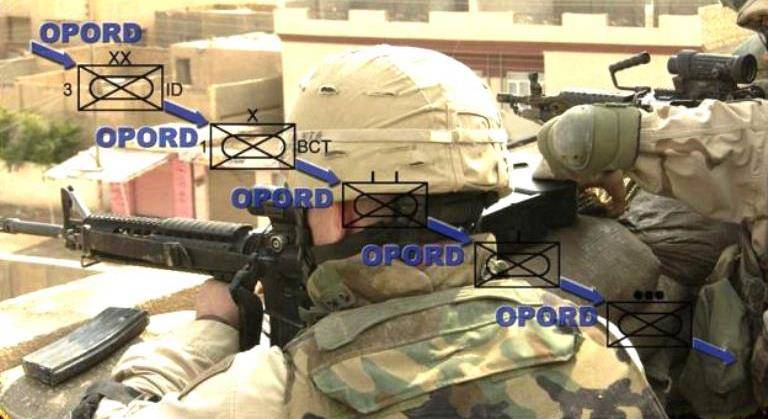
FRAGO
This combat order is an abbreviated form of a combat order. It is usually written daily to update the information that is used in the main OPORD order. It is given after OPORD for making changes to it (for example, only changing the task: they should have blocked the enemy, and now they should destroy) or to perform any of its sections or paragraphs.
A typical example of using FRAGO is when you suddenly come across a firing point. Here the commander needs to regroup his forces and means of fire, quickly draw up an action plan or switch to a fallback option. Planning all these actions for execution, he issues (as we would say - on the knee) the FRAGO order.
After its completion, the commander goes back to the execution of the main combat order OPORD.
The command and control procedure is a dynamic process used by small unit commanders to analyze a mission, develop a plan, and prepare for an operation. These procedures, or TLPs, allow commanders to make the most of their planning time, including developing effective plans and preparing units for an operation.
Thus, command and control procedures provide commanders with a proven planning and decision-making process by which they can efficiently and quickly plan, prepare and execute actions at the company level and below.
Stages of work in the TLP procedure
(We are considering this procedure in relation to the platoon).
The TLP procedure consists of eight steps (steps):
1. Obtaining a combat mission.
2. Issuance of a preliminary combat order (WARNO).
3. Development of a preliminary plan.
4. The beginning of the movement.
5. Conducting reconnaissance.
6. Completion of the plan.
7. Issuance of a combat order (OPORD).
8. Refinement and improvement.
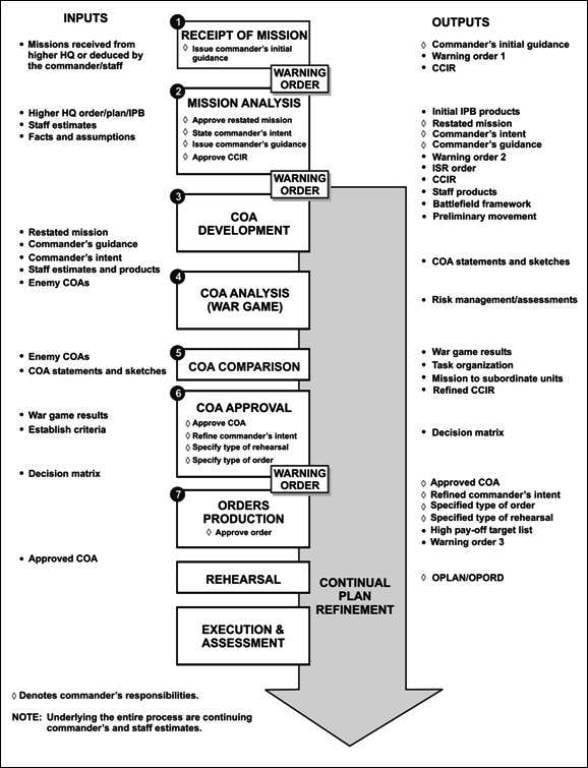
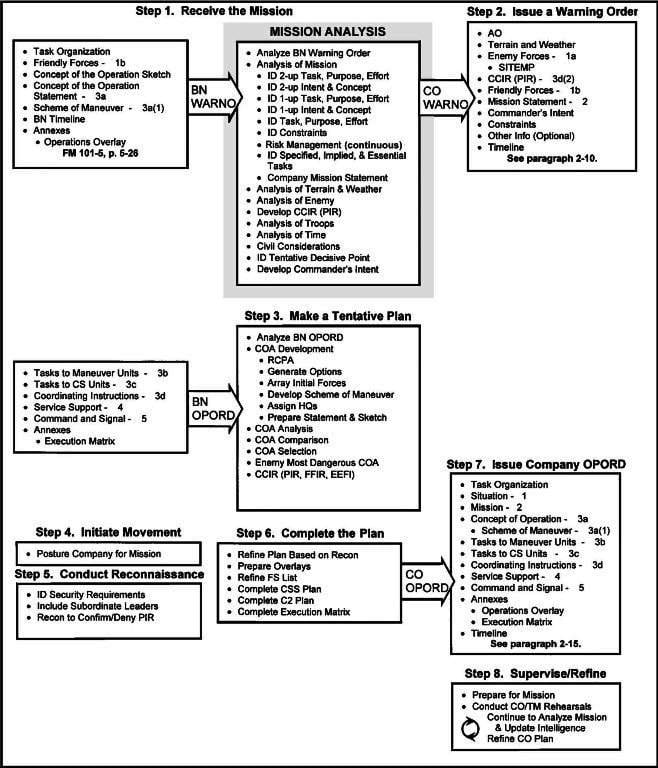
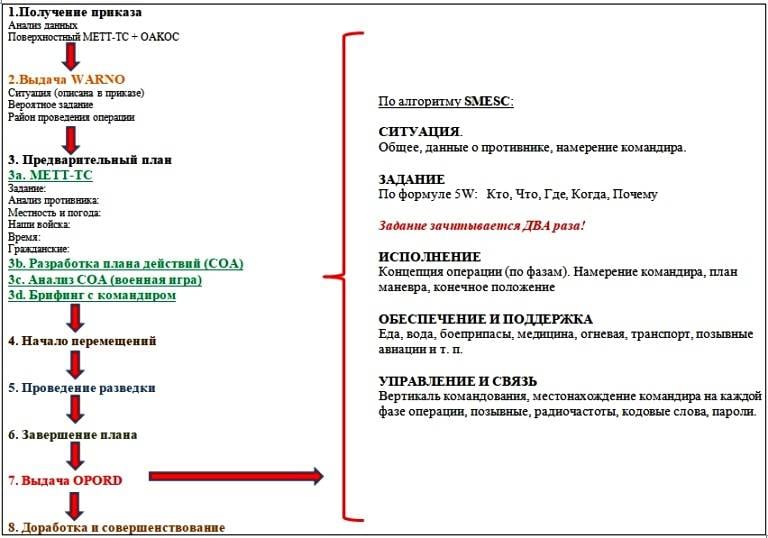
The sequence of these TLP steps is optional. Leaders can change the sequence based on mission conditions, environment and available time.
Some steps are performed simultaneously while others can be performed sequentially during the operation. But the first three stages of TLP (receiving a task, issuing a preliminary combat order and developing a preliminary plan) always go sequentially, without rearrangements.
Step 1: Obtaining a combat mission
This can be either a combat order to carry out OPORD, or a preliminary WARNO order, and then a fragmentary FRAGO order, received orally, in writing (on a special form), by radio, etc.
This step begins by receiving an initial WARNO from the senior commander. It can also start when the platoon leader receives an OPORD, or it could be due to a change in the general situation. Receiving a mission initiates the planning and preparation process so that the platoon leader prepares his initial WARNO faster.
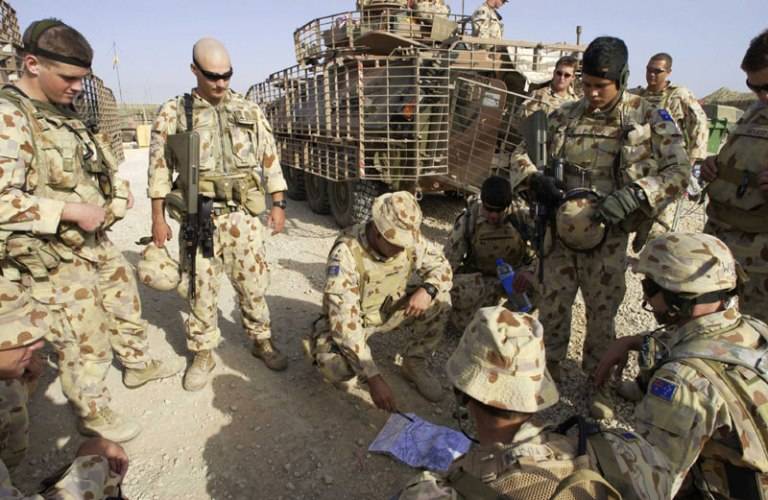
At this point in the TLP, the task analysis should focus on defining the unit's mission and the amount of time available. For the platoon (squad) commander, the mission analysis is essentially an analysis of the METT-TC factors, but should not be involved in the detailed METT-TC analysis. This will happen after the initial WARNO has been issued.
Below is a sample form, which shows the sequence of the commander's work when receiving a task and what exactly he must do in the first place to start work on his order.
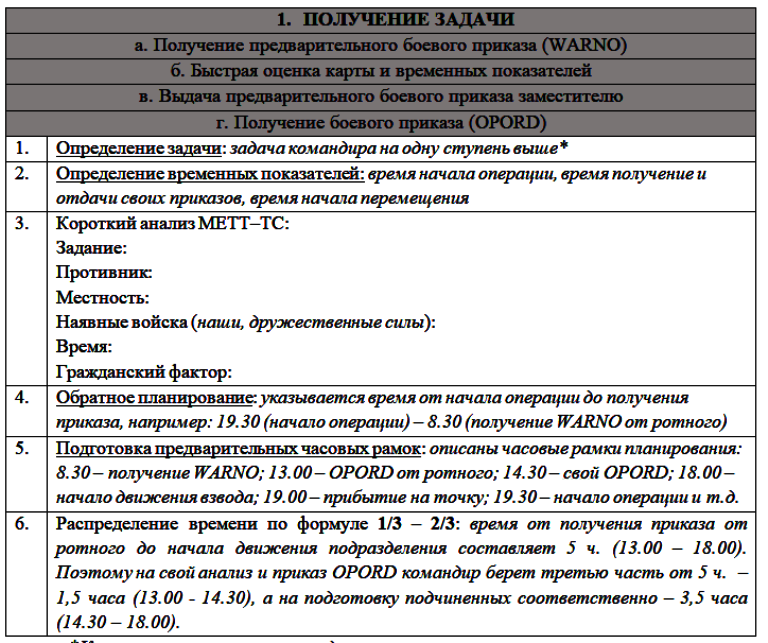
So, when receiving a task, the subunit commander must conduct an operational analysis of the task, provided for by the order of the high command, using the METT-TC tools (see item 3 in the table above).
A TASK - The commanders review the preliminary combat order or combat order to determine how their unit can contribute to the fulfillment of the task of the higher headquarters.
The platoon leader familiarizes himself with the platoon's task in point 3 WARNO of the company commander (see the diagram above - step 7, sub-points "concept of operation, maneuver"). At this point, the company commander reads out the task of each platoon, and the commander of a certain platoon in his notebook writes down only the tasks of his platoon. The mission of the other two platoons need not be written down.
Your assignment should contain answers to 5 basic questions: who, what, where, when и Why?
There are two most important issues here: that is the only tactical mission (for example, destroy, capture or block) and why does it have to be done?
The commander must be able to demonstrate understanding by summarizing the concept of high command within the next two highest levels (company and battalion). It is important to know where exactly your place in the big picture is. If you fail, the company’s mission may be in jeopardy.
Also, the commander must familiarize himself with the task of each squad (for example: from 1 platoon, 1 squad is allocated to a reconnaissance patrol) and the tasks of adjacent units, as well as determine their location on the map. This will help determine the destination / area of operations of the platoon, as well as understand how your mission and goal relates to the tasks of the highest level commander. Commanders must understand the concept within the next two highest levels.
ENEMY - WHO, WHAT and WHERE. Basic information about the enemy can be obtained in paragraph 1a WARNO of the company commander, as well as in any attachments that are attached (for example, from the reconnaissance form). In this case, it is necessary to immediately determine the known and expected location of the enemy on the map. This will help the commander navigate the situation. Also, the commander needs to present a larger picture of the general activity of the enemy.
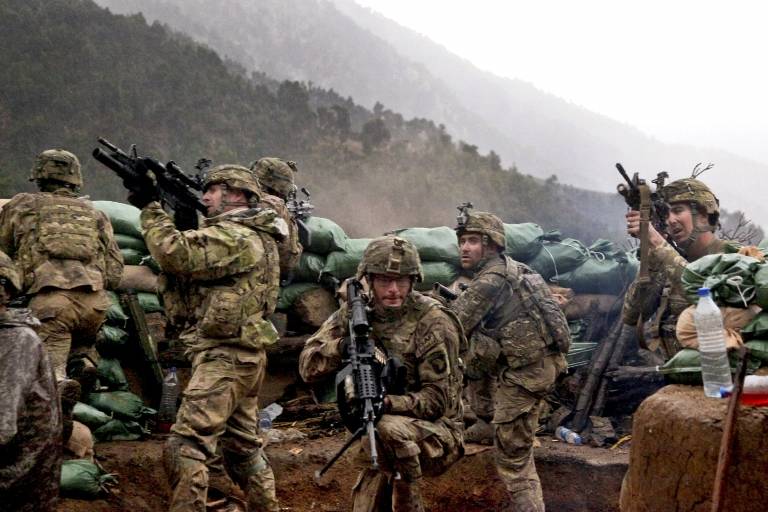
LOCATION - Briefly identify only the main relief elements that will directly affect your operation. For example, you must cross a bridge en route to your destination. A careful study of the route will give you data on the characteristics of the roads, trails, and also ensure that you do not need to move through the swampy area, spending a significant part of the time.
On the other hand, if there is no reconnaissance information about the bridge (destroyed or mined), you need to take into account the time for reconnaissance. Remember that you will be acting within tight deadlines. The more time you spend here, the less time you will have to carry out your preliminary combat order.
TROOPS - immediately determine who you are dealing with, the available formations, units and resources, the presence of friendly forces or partisan detachments.
CIVIL FACTOR - information about the presence of civilians in the area of operation, their number, moods, religion, etc. The commander receives this information, as a rule, from the senior commander or from intelligence reports.
TIME IS THE MOST IMPORTANT QUESTION! Here we need to determine how much time we have to prepare for the operation. Analyze the plan from target to preliminary combat order - that is, here temporary planning is in progress, but in reverse order... To do this, use the formula 1/3 - 2/3, which allows you to determine the time that you have left before the start of the operation (if not indicated in the order of the high command). For example, the time from the issuance of his OPORD (14:30) to the start of the platoon movement (18:30) is 4 hours. This means that the commander allocates no more than 1 hour for himself (task analysis, order drawing up, etc.), and 3 hours is allocated to prepare subordinates for the task.
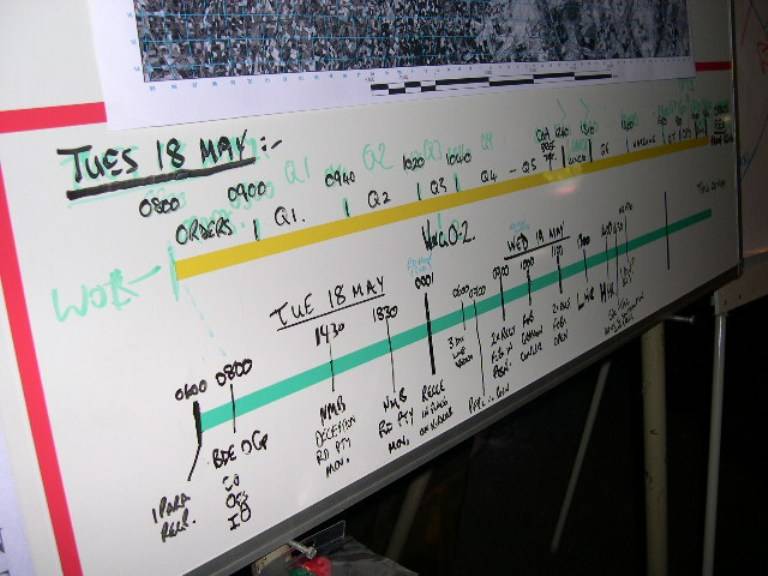
Concentrate your efforts on creating a detailed timeline from the preliminary battle order to the start of the operation. The time that will be determined after the start of the operation will be characterized as "KEY".
The initial planning and preparation timeline is critical to the advance order and is the most important input to your operational analysis. It will help you understand how much time you have for planning and preparation.
It should be noted here that, having received an order, the commander analyzes it and after 5 minutes. communicates the order of the senior commander to the personnel in the most general terms. This is done so that the subordinates know what they have to do, where and when, and also says when he will issue his preliminary order (usually in 20-40 minutes). Next, the commander goes to develop his WARNO.
Remember! The preliminary combat order is only information for subordinates on the general situation and for preparation for battle. At this stage, you do not develop your own course of action.
Step 2: Issue a preliminary battle order (WARNO)
Reading out the preliminary order (always at the card with the display), the commander gives the initial instructions in the order of preliminary information, which contains enough data to start training as soon as possible. At a minimum, the order should contain an updated situation, the current mission data, the time and place of issuing your OPORD, the time of the start of the movement and the time frame.
It should be indicated who will carry out all preliminary orders, as well as the actions that they must take after receiving them: for example, obtaining ammunition, dry rations and water, checking communication equipment, starting time and time for submitting an order, conducting additional reconnaissance, creating a terrain model and etc.
A few words about the terrain layout.
The layout is created if time permits. For this, 1–2 people are allocated. To create it, special sets of objects can be used (multi-colored ribbons, boxes, bottle caps, etc.), but most often improvised materials. In this case, it is necessary that the details of the relief, as far as possible, correspond or approach the color scale of the area. For example, vegetation is indicated by green threads (ribbons) or grass, leaves. If there are hills (lowlands) on the terrain, then they must also be depicted: fill the ground or dig a hole, etc.
You also need to remember that to designate the same objects, you must use the same materials: if houses are designated by pebbles, then they show all the houses, and not half as pebbles, and half as pieces of wood. This makes the layout easier to read.
A prerequisite for creating a layout is its orientation along the sides of the horizon and an arrow pointing to the north. Also, the layout can be divided into conditional squares using pegs and a cord stretched at a height of 30–40 cm above the layout.
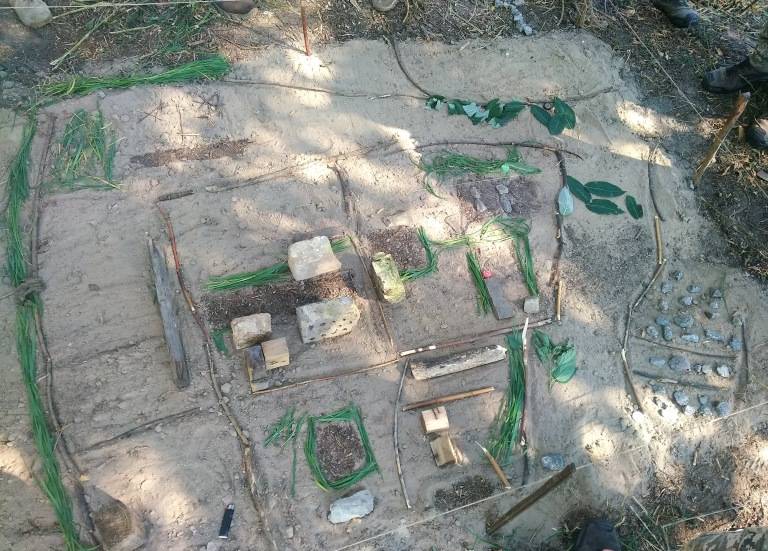
Advance directives are not in a specific format. One way is to use the five-paragraph ordering format, or SMESC: situation, task, execution, provision and support, management and communication. The commander issues a preliminary order with all the information he has at the moment.
1. Situation. Its analysis is carried out necessarily on the map.
A. Area of operation. Here you need to define the area of operations where the operation will take place, including the surrounding areas that may affect the performance of your operation. It is assigned to the unit by the highest headquarters.
B. Enemy. The last positions and activity of the enemy (who, what and where) are indicated.
C. Our troops and friendly forces. Indicate which friendly forces are operating in the area. Here, friendly forces are understood as units of the allied army, partisan detachments, etc., but not their own troops. Determine the location and plan of the high command units and allied units. Indicate the intent of the high command. This will give your subordinates a "general concept".
D. Attached and taken away forces and means. List the units that are attached to your unit or act as your support (artillery, sappers, grenade launchers, etc.). Determine when each unit or unit is effective.
2. The likely task of your unit. At this point, the probable task of the platoon is announced (in the squad the task of the squad and (if necessary) each soldier or group). As stated above, the task is described in five steps: who, what, where, when, and why.
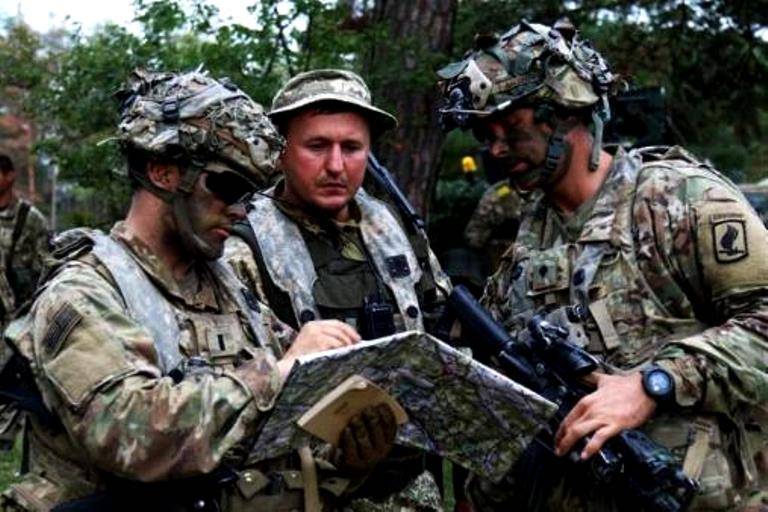
3. Execution. At this point, the area of operations of the platoon (squad) and its coordinates are determined. For a platoon, points (areas) of actions of squads are also marked with the indication of coordinates.
4. Provision and support. Here are the instructions on the amount of ammunition, water, food ration, what form and ammunition to use, etc. Also in this paragraph indicate the rules for the use of weapons (see below) and the provision of transport.
5. Management and communication. The radio frequencies of the squad and platoon are determined, if they are not indicated by the senior commander. The order of subordination and the sequence of transmission of orders are also indicated (as a rule, according to the vertical of authority from the group commander to the squad leader or from the squad leader to the platoon chief sergeant, and he - to the platoon commander).
It should be noted that the order indicates a preliminary task (mission), which is mandatory repeats 2 timeswho participates in the operation (own and neighboring units, friendly forces), the time of the operation (the beginning of the operation, the time of its completion and return to the base), the time and place, and also who will be present when the combat (operational) order is issued (in a platoon - these are the squad leaders, the chief sergeant of the platoon, and in the squad - all the personnel of the squad).
In this order, as in the combat order, it is necessary to pay attention to paragraph 4 a "Rules for the use of weapons".
This paragraph is a prerequisite for the conduct of hostilities in populated areas or during peacekeeping operations, as it outlines the legal conditions for the use of force and weapons against the enemy and civilians. It notes that weapons and military force will be used in accordance with the rules for the use of force and international humanitarian law. The wording will be as follows: "In accordance with the Rules on the Use of Force (IPR) and International Humanitarian Law (IHL)" or "In accordance with IPR and IHL".
We will briefly describe some of the points of these rules and rights in order to reveal the content of the above phrases of this paragraph.
Thus, in "Instructions on the procedure for implementing the norms of international humanitarian law ..." in paragraphs 3 and 4 it is written that in order to prevent unnecessary suffering and unnecessary casualties among the civilian population, causing large and long-term damage to the natural environment associated with military operations, prohibitions and restrictions are established in the choice of methods and means of conducting military operations:
- kill or injure civilians;
- to kill or injure persons who are recognized or who, under the given circumstances, should be recognized as persons, that they are out of action (hors de combat);
- kill the negotiator and the persons accompanying him;
- to attack persons who are shipwrecked or leaving by parachute an aircraft in distress, who do not render hostile actions (with the exception of persons who are landing as part of airborne assault forces);
- to give the order “not to leave anyone alive” or to threaten them;
- taking hostages;
- to mislead the enemy by treachery;
- not to carry out military actions not aimed at specific military targets;
- use explosive bullets and bullets that easily unfold or flatten in the human body (bullets with a hard shell that does not completely cover the core or has notches).
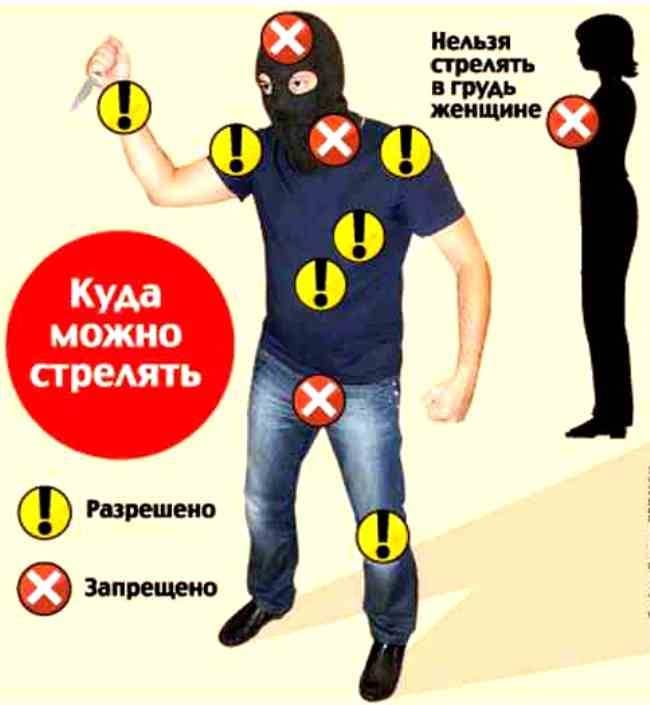
In the manual "Training essays on peacekeeping operations with possible solutions" (subparagraphs 1-5, 9) it is indicated that the military is allowed to use force (weapons) only if necessary and observe the following rules:
- the right to use the necessary minimum force, including fire to kill, with a service weapon to protect oneself from hostile intentions and actions; to protect friendly troops, people and property under your protection from hostile actions and intentions;
- before using weapons (force), it is imperative to inform the attackers aloud about your possible use of weapons (force);
- if the operational situation does not allow to carry out a hail, the weapon is used: when you or other people are subjected to an armed attack; in the event that the use of a hail before opening fire will result in death or injury by you or other people;
- you may open fire against those who carry out a hostile act or demonstrate hostile intentions and if the hailing procedure is insufficient or inappropriate;
- if a person shoots at you, aims at you, prepares to throw a grenade (pulled out the pin), an explosive or incendiary device (set the fuse on fire, etc.);
- when a person tries to take possession of weapons, ammunition, property or intentionally drives a vehicle towards you, friendly forces, people and property that you are protecting, etc.
Minimum Force Requirement:
- when the use of force is required, you must use the minimum amount to achieve the immediate goal. Try to minimize possible damage. You may not intentionally attack civilians and property that is purely civilian or religious, unless the property is used for military purposes, etc.
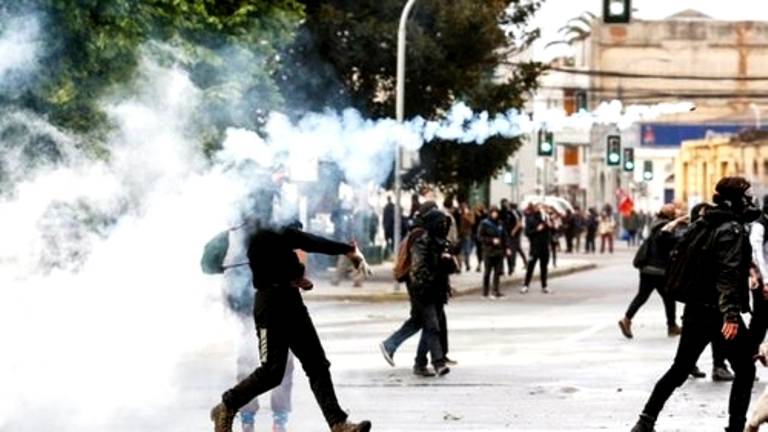
So the WARNO order should include the following information:
- The purpose or nature of the operation (task definition).
- Time and place of the beginning of the operation (time frame and area of operations).
- The composition of the forces and means allocated to participate in the operation, as well as instructions for interaction.
- Duration of surgery (graph).
During this phase, the commander tries to present his role within the task in order to quickly prepare a preliminary order for his subordinates. To work effectively, he needs to have all the tools available.
Below is an example of a formalized WARNO form for a platoon leader.
Orientation of the map to the terrain. Determination of the northern, southern, eastern and western boundaries of the area of operations (squad, platoon, company), as well as terrain features.
Brief communication of information about the area in accordance with the description.
Description of the area
Current location (ours).
North direction.
The main features of the relief.
The main ways of providing.
Settlements.
1. SITUATION (S)
a. Enemy.
b. Friendly forces.
v. Battalion commander's plan (this is for the platoon commander; the company commander's plan was for the squad leader).
d. Attached and taken away forces and means (for example: detachments of sappers, mortars attached to us, a platoon of tanks, etc.).
2. PROBABLE TASK (M) of the platoon:
__________________________________________________________________
I repeat:
__________________________________________________________________
3. VERSION (E)
Place of return OPORD:
a) location,
b) the required l / s,
c) time,
d) coordinates of the area of the operation.
Platoon area of operations ___: ______________________________
Square (coordinates): ______________________________
Deputy platoon commander (coordinates of targets, objects for squads):
Section 1: ____________________________________________________
Section 2: ____________________________________________________
Section 3: ____________________________________________________
4. SUPPORT AND SUPPORT (S):
a) rules for the use of weapons _______________________________
b) transport _____________________________________________
5. CONTROL AND COMMUNICATIONS (C):
_________________________________________________________________
Passwords ____________________
Reconciliation of hours.
"Questions" (subordinates ask, clarify points that they did not fully understand or did not fully write down).
Questions to subordinates (how you understood the task, everything is clear, etc.).
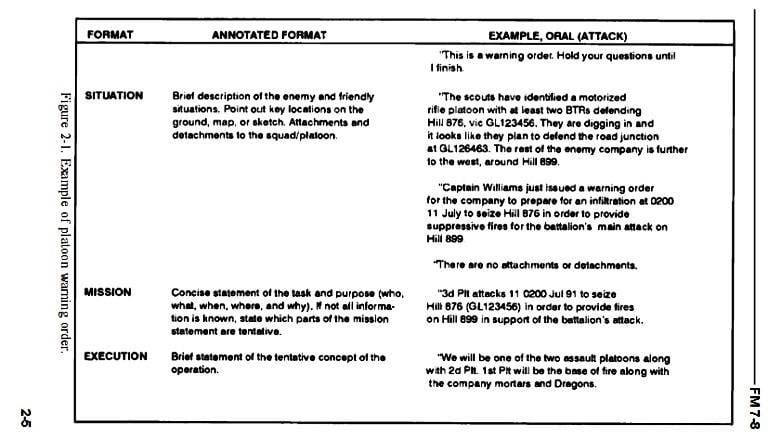
Step 3: Develop a preliminary plan (SOA analysis)
Immediately after issuing a preliminary combat order, the commander begins to develop a preliminary plan. As a squad leader, you can involve your subordinates - in particular, during the development, analysis and comparison of the action plan. However, as the squad leader, not your subordinates, you choose the course of action on which your plan will be based. To form the foundations of the preliminary plan, the commanders conduct a task analysis. This analysis is carried out in the METT-TC format.

1. Mission (task).
Detailed understanding of the received combat mission:
1. The concept and design of the higher command is two levels higher, which is set out in subparagraph 1b of the received combat order, and the intention of the immediate superior is in paragraphs 2 and 3.
2. The tasks of the unit. These are tasks that are clearly stated in the order (immediate tasks), or tasks that are identified during the study of the received combat order (incidental or additional tasks).
The formulation of the received combat mission is a clear, concrete statement of the subtasks necessary for the fulfillment of the main combat mission and the goals to be achieved.
The clarified problem is formulated as follows: WHO WHAT (exercise), WHERE (usually rectangular coordinates), WHEN (time) and WHAT FOR (the goal that the unit must achieve).
Below are examples of how to formulate tasks:
1. (WHO) 2nd platoon (WHAT) blocks the enemy (WHERE) at an altitude of 184,0 with coordinates 3944-3 (WHEN) at 05:00 local time on April 11, 2020 (WHY) to support the main efforts of the company on destruction of the enemy platoon strongpoint.
2. (WHO) 1st platoon of company B defends (WHAT) the strong point (WHERE) with coordinates from AC183476 to AC183490 and from AC133496 to AC133466 (WHEN) from 13:30 local time on June 16, 2021 (WHY) to prevent the enemy's coverage of the C 2/45 Cavalry Regiment from the eastern direction.
An example of an immediate task:
1. To equip the NP at the point with coordinates GM124425 at 12:00 on October 11.10.2021, XNUMX.
Examples of additional tasks:
1. Replenish stocks.
2. Organize interaction with neighboring units.
Subtasks. After examining all of the above factors, the commander draws up a list of subtasks or tasks that may arise during the execution of the main task. Failure to fulfill these subtasks leads to the disruption of the main combat mission of the subunit.
Such subtasks are set out in the subparagraph "Maneuver" of the received combat order. For example, there is a bridge on the way. We do not know whether it is destroyed or not, whether it is mined. If the bridge is destroyed, then we will not be able to complete the main task in time. Therefore, the commander must determine in advance the time and number of people for reconnaissance of this bridge.
Some examples of subtasks:
1. Avoid the swampy area near the stream.
2. On the way, replenish ammunition at the "Ball" point.
Restrictions. Then the commander, in the received combat order, determines all the instructions that restrict his freedom of action. These provisions are restrictions. There are certain restrictions for the unit in each operation.
Some examples of general restrictions:
1. Be at the starting point "Bravo" at 12:10 on 28.10.2021.
2. Move in radio silence mode.
Focusing his attention on the identified task, starting from the first stage, the commander continues the process of assessing the situation using the remaining METT-TC factors:
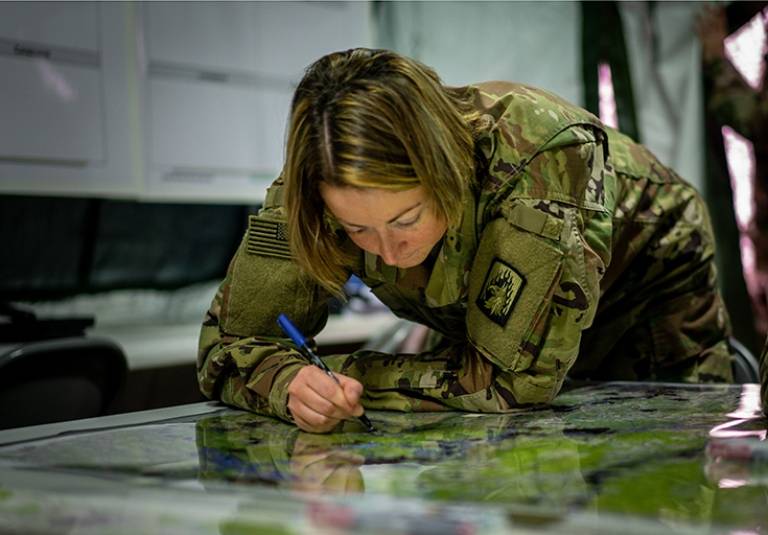
2. Enemy analysis (analysis of the enemy).
What do we know about the enemy?
For this, the SALUTEHIM procedure is used:
Size (number),
Activity (activity, actions),
Location
Uniform (uniform),
Time (time) or Tactik (tactics),
Equipment (equipment, weapons),
Habits
Intent (intentions, intention),
Morale (fighting spirit).
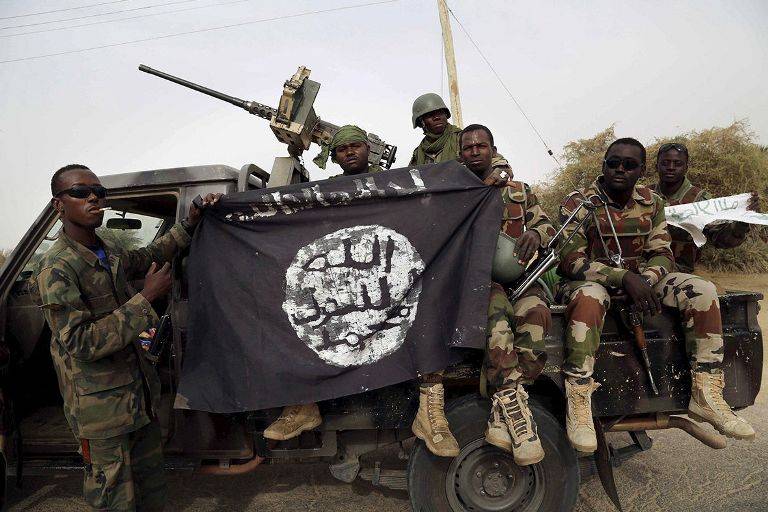
1. Number. The composition of the forces and means that the enemy can have is analyzed, what subunits, detachments, and groups are active in terms of numbers?
2. Activity. How and whom does the enemy attack, for what purpose? Or the enemy is preparing for defense.
3. Location. Does the enemy's location determine how and in what area he is located on the ground, for example, in defense, in areas of concentration, or how does he move in march formations? Or in which areas was it active?
4. Dress code. How is the enemy dressed - in a military uniform, in civilian clothes or mixed military-civilian clothes?
5. a) Time. How long has the enemy been active, since when has he occupied these positions?
5. b) Tactics. What tactics does he use: an ambush attack, a raid, an attack with the help of armored vehicles or with the support of artillery (aviation) etc.
6. Weapons and equipment. It is determined what weapons systems it has (small arms, heavy, mixed), what is included in the equipment (night vision devices, camouflage suits, climbing equipment, etc.).
7. Habits. Acts openly, hides his actions, uses the local population, etc.
8. Morale. High, low, depressed.
9. Possible courses of action. Both the possible options for the enemy's actions and the most dangerous one are determined. This analysis ensures that their troops are not caught off guard during the operation.
3. Terrain and weather (terrain and weather).
How will LOCALITY and weather conditions affect the operation?
It is necessary to study the terrain using factors OAKOC - Obstacles, Approach routes, Key area, Observation and firing sectors, Camouflage.
1. Obstacles. The existing, as well as possible obstacles and difficult-to-pass areas of the terrain, which will affect the mobility of troops, are determined.
2. Routes of approach. Routes of advance to the target are determined, taking into account their passability, camouflage properties, both for their troops and for the enemy. Air and underground routes should also be considered:

a) in an offensive: how will these routes ensure the movement of their troops? What are the advantages and disadvantages of each of them (consider in terms of enemy actions, movement speed, camouflage properties)? What are the most likely directions for enemy counterattacks?
b) in a defensive environment: how can the enemy use these routes? Which routes are the most and least dangerous (prioritize them)? What routes can provide a counterattack?
3. Key areas of the area. These are areas that impede, delay or positively influence the hostilities of each of the warring parties. Using a map or other information about the terrain, the commander assesses the key areas of the terrain that dominate the advance routes or target (object). Further, areas of the terrain are determined, which, when occupied, will decisively influence the implementation of the task.
4. Sectors of observation and firing. Positions are determined that provide the best conditions for observation and firing along the routes of advancement, near the target (object) or in important areas of the terrain. The analysis of the sectors of firing is mostly related to the ability to shoot through the terrain with direct fire.
5. Protective and camouflaging properties. The analysis of camouflage and defensive properties is often an integral part of the analysis of surveillance and firing sectors. Firing positions must ensure both effective firing from weapons and their survivability.
Infantry units can improve camouflage and defensive properties by entrenching and camouflaging their positions. When moving, the terrain is used in such a way as to ensure secrecy.
The analysis is carried out by filling in special tables (see below).
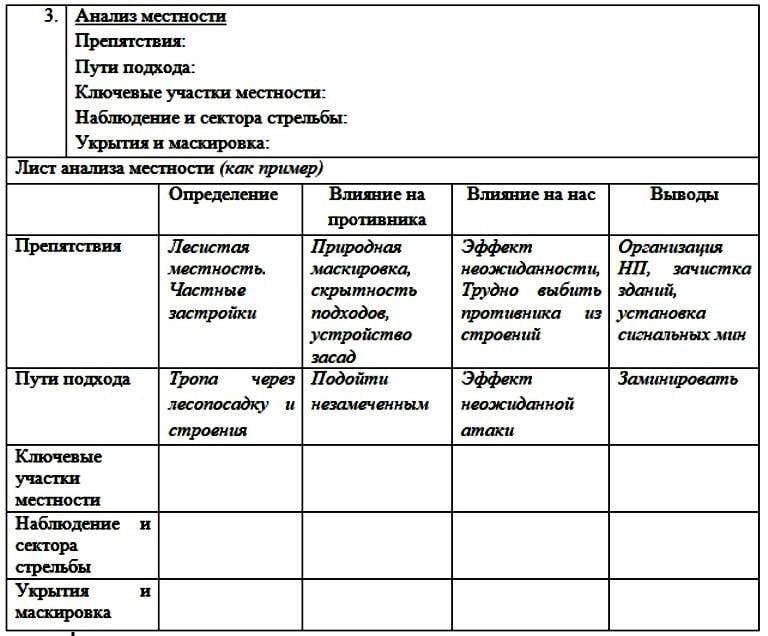
4 Troops available (our troops):
Amount: platoon.
A type: mechanized.
Features: ambush.
Support: mortars or lack of support.
Medicine: 1 car per company, a pair of stretchers, individual first aid kits.
Armament: standard platoon armament.
Required level of training: base.
Fighting spirit: tall.
Time (time).
Available time:
Time to develop a preliminary plan: 1 час (11:00–12:00).
Time to write OPORD: 1 hour 30 minutes (13:00 - 14:30).
Time for training: 1 hour (15:00 - 16:00).
Time to reach the target location: 25 minutes (19:00 - 19:25).
Time spent on GOAL: 1 hour 30 min (19:30 - 21:00).
Time to return to base: 30 minutes (21:00 - 21:30).
Civilian considerations (civil).
Are there civilians in the area of operation?
If so, how will they affect the operation? Or how will the operation affect the civilian population?
This necessarily includes the location of places of worship in the area of operation, so as not to destroy them and not cause religious anger on their troops.
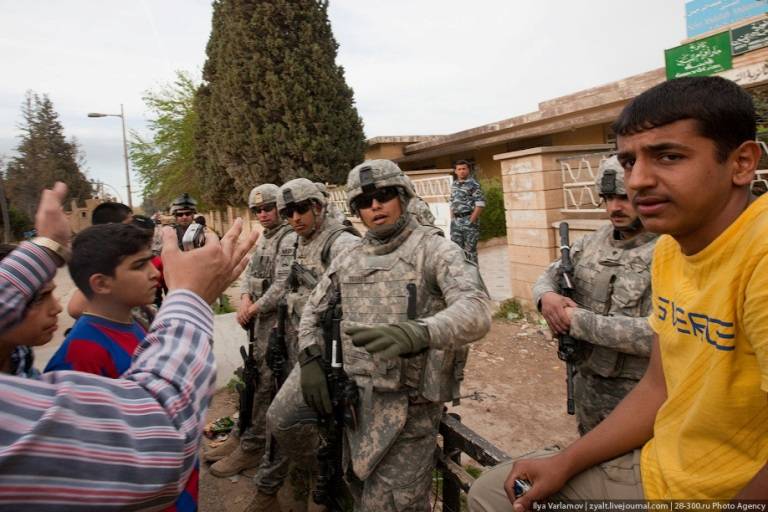
Developing and defining possible courses of action (COA)
The options for actions that the commander develops should be:
- Realizable, that is, they must lead to the fulfillment of the task and support the commander's plan.
- Reasonable, that is, the subunit must remain an effective combat force after completing the mission.
- Diverse, that is, different options for action should be significantly different from each other, as well as from the previous ones. That is, actions should not be stereotyped.
After determining the possible options for action, the subunit commander, together with the higher headquarters, determines the organization of the troops, including all staff and attached forces and assets, and prepares a list and diagram of possible options for performing the task. The diagram indicates the main and alternate routes of approach to the target, the main and alternate escape routes from the target, as well as, if necessary, the points of evacuation, collection or points of divergence of the unit in groups and directions.
Analysis of possible options action (staff game).
Such an analysis is carried out by playing out various options for the actions of friendly troops against the most likely options for the enemy's actions. This is the "wargame" that we talked about in the first part, which is carried out according to the "action - reaction - reaction" scheme. A war game can be played on developed schemes, on a map or on a terrain model.
Examples of questions that can be played in the "wargame":
- enemy - what are you doing at this time? - their troops - your reaction - enemy - what will be your opposition?
- Good. Engineers, what are you doing now?
- Fire support officer, what are your actions at this stage? etc.
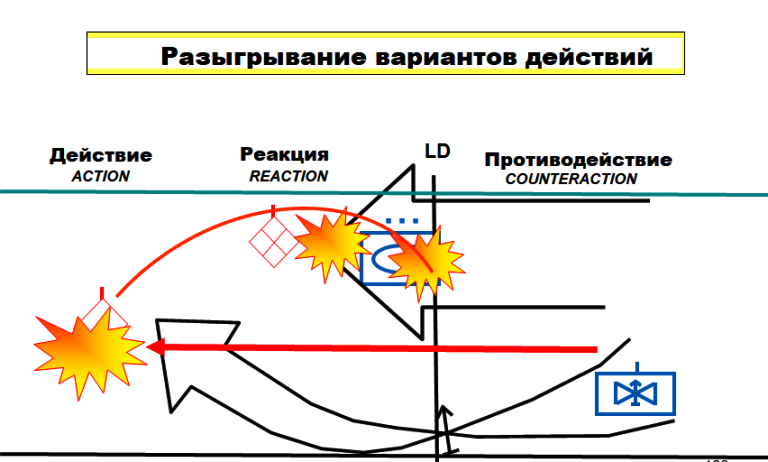
Comparison and selection the best course of action. The commander compares all options for action and chooses one that is most likely to lead to the task. In doing so, he considers the advantages and disadvantages of each option. The possible influence of various events on them is also considered.
Decision-making... The commander chooses the option of action that, in his opinion, gives the best chance of completing the assigned task.
Below are the tables in which the development and selection of the optimal solution takes place.
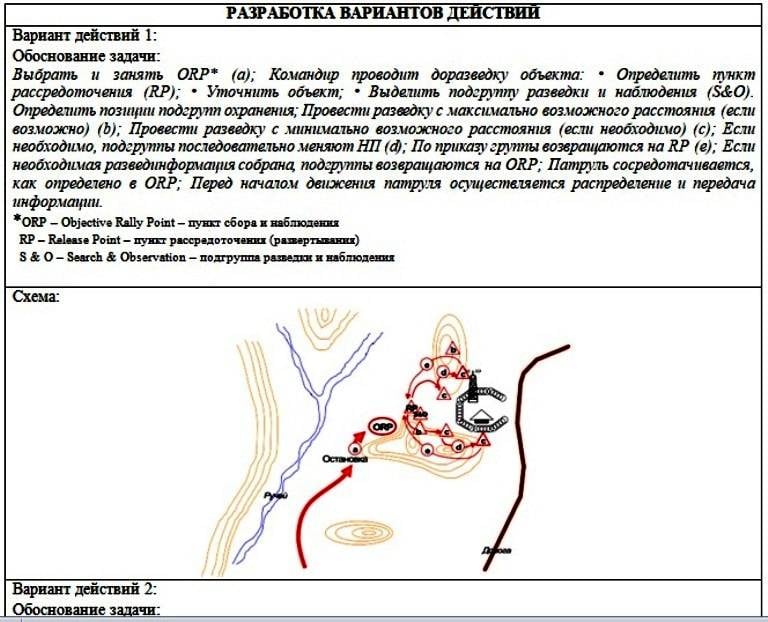
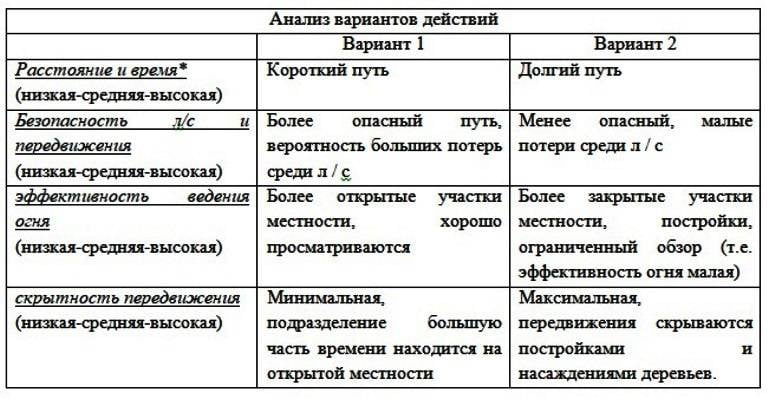
Italic the table provides examples of actions that are analyzed in terms of safety, effectiveness, minimum effort, etc. They may be different and there may be more.
Low-Medium-High Is an assessment of the safety and effectiveness of an action. Accordingly, low - 1 point, medium - 2 points and high - 3 points. This estimate is required for the table below.
Having thus analyzed the plans for the above table, each action is assigned points - 1, 2, 3, as we have already spoken about. These points are entered in another table and summed up. The best option is the one that scored more points.
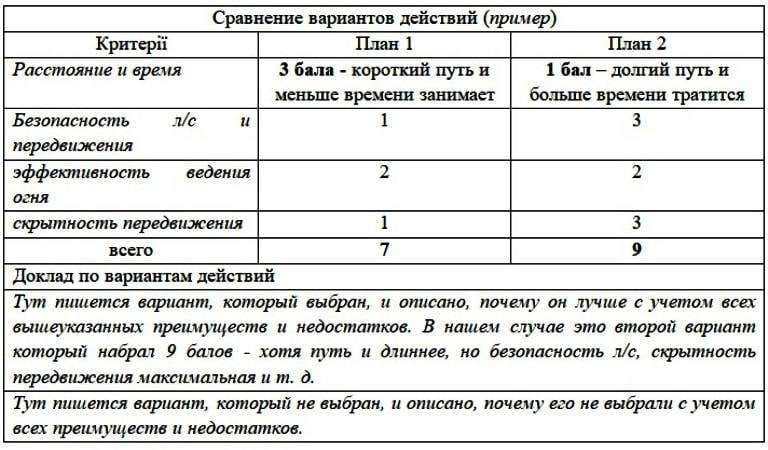
Step 4: Beginning the required actions (movements)
This stage can take place at any time in the planning and command and control process. The unit may need to start some action while the commander continues planning or conducting reconnaissance. For example, move to a gathering area that is closer to the front line. This also includes the preparation of the terrain model (if there is enough time), which begins immediately after the issuance of WARNO.
Such movements are possible in the area of concentration, the starting area, the area where the tasks are performed, or the replacement of units that are located there.
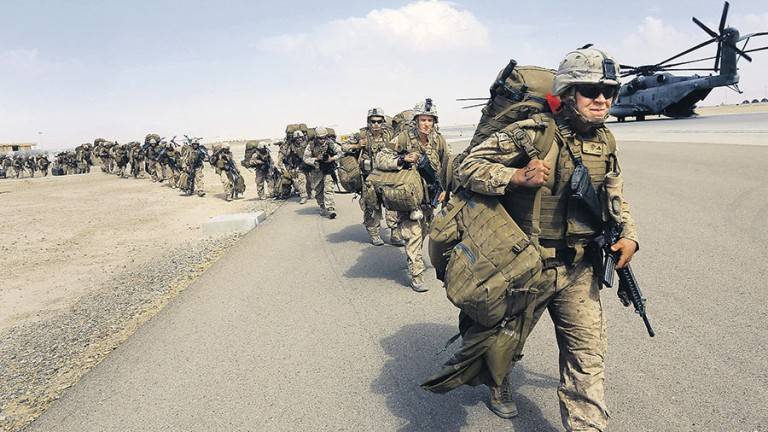
Step 5: Conducting reconnaissance or reconnaissance
This step can be performed immediately after issuing WARNO, if the commander has allocated scouts from his subordinates for this. If time permits, the platoon leader carries out field reconnaissance personally. If time does not allow, the commander carries out reconnaissance on the map, aerial photograph. Sometimes, when conducting reconnaissance, he must rely on other sources of information (for example, from reports from the highest headquarters or from scouts of a neighboring unit), which can directly affect the adjustment of his own plan.
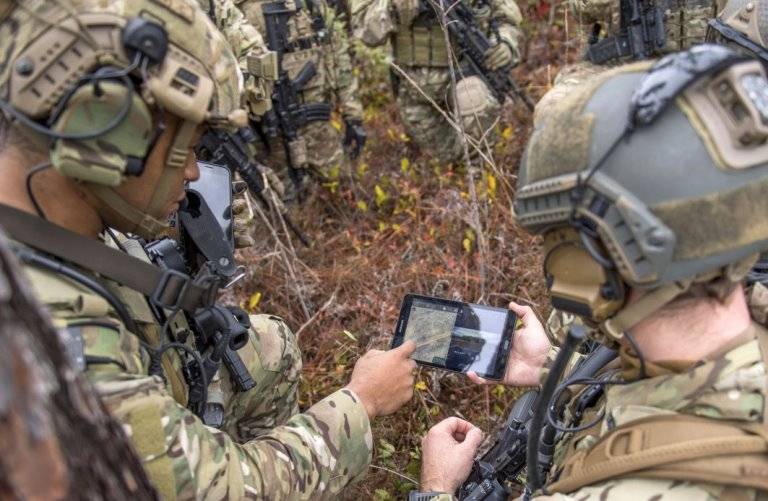
Step 6: completing the plan
The commander completes his plan based on his intelligence data and all changes in the situation. He also needs to make sure that his plan is in line with that of the senior commander by going to his commander for a briefing. Here the plan of the operation is checked, if necessary, updated data on the enemy, situation or operation are brought up. After that, the operation plan is approved or sent for revision.
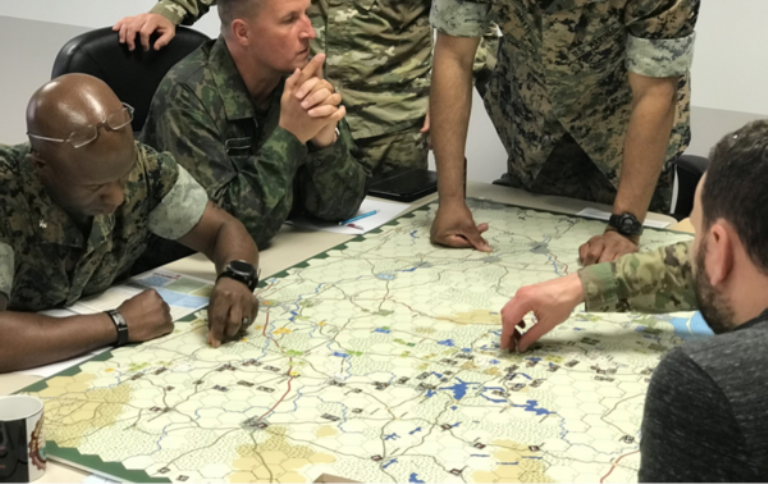
Продолжение следует ...
Information